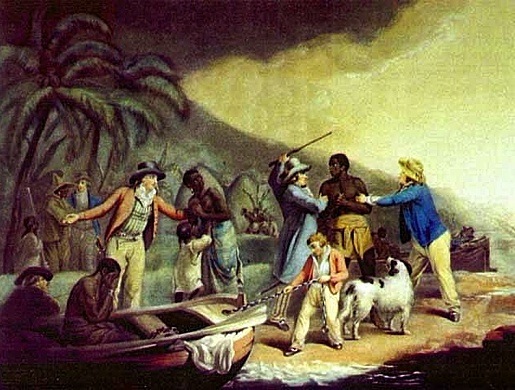By Carrie Halperin on 15 July 2012 for Yahoo News -
(http://news.yahoo.com/changing-cities-ending-hawaiis-oil-addiction-103101000--abc-news-tech.html)
[IB Editor's note: By playing of Oahu's suburban anxiety about losing their "Grid & Gas" plans are underway by the powers that be to spend billions on boondoggles (like the $billions in undersea high voltage lines) to service Honolulu from the Big Island and Lanai. The plan is to provide "alternative" energy farms on the outer islands. Moreover the Pacific Command would like ethanol producing plantations and even algae farms to furnish power for alternatively fueled operations. Sounds like the perfect compliment to the GMO plantations the corporations are running now. We say bring on the financial collapse now!]

Image above: African forced into slavery to work plantations in the Caribbean by George Morland ~1790. From (http://www.sterlingtimes.org/morland35.htm).
When you think of the most innovative places around the world for clean-tech, Denmark, where 50 percent of the energy comes from wind, might come to mind. Or maybe you'd think of Iceland, which is almost nearly 100 percent powered off geothermal, or perhaps Germany, which recently set a new world record in power generated from solar, but Hawaii?
U.S. Pacific Command is working closely with Hawaii, the most oil addicted state in the nation, to ensure that the Hawaii Clean Energy Initiative, a plan launched in 2008 to reduce the state's consumption of fossil fuels by 70 percent by 2030 is a success.
The military is using the Hawaiian islands as a test bed for new green tech innovation - everything from algae-based jet fuels and hydrogen fuel cell technology to smart-grids that can resist cyber terror.
Some of these efforts will be showcased on July 18, when the Navy tests a carrier strike force using alternative fuels during the six-week, 22-nation Rim of the Pacific exercises, the largest annual global naval maneuvers.
The ships and aircraft will be powered by alternative fuel, either nuclear or advanced biofuel blends. The biofuel blends are 50-50 mixtures of biofuel (made from used cooking oil and algae) and petroleum-based marine diesel or aviation fuel.
The new "Green Fleet" is not without its critics.
Conservative lawmakers came out this month in opposition to the U.S. military's use of advanced biofuels, claiming that they are concerned about the cost of these new, nonoil fuels. Sen. John McCain, R-Ariz., the ranking Republican on the Senate Armed Services Committee, said, "I don't believe we can afford it."
The Navy purchased 450,000 gallons of biofuels for $12 million in 2011 for the maneuver - $26 per gallon.
Pacific Command contends that the need to invest in biofuels is evident.
"The Department of Defense's military expenditures on fuel is about $15 billion, 3 billion of that was unbudgeted simply because of the change in the price of fuel," Simonpietri said. "The reasons for using biofuels, from a military utility point of view, is for national economic security, it's part of the interest of the nation, and really having different options that can address price volatility."
Connecting the Islands
Beyond the military's efforts, the state - which currently imports 90 percent of its energy in the form of oil - is proposing a mega-construction project to build an underwater cable connecting renewable energy projects on the islands.
"Hawaii is taking on renewable energy and using that as a solution to really reduce our vulnerability to imported oil," Mark Glick, Hawaii's energy administrator, told ABC News.
"Our (current) power generation comes from low sulfur fuel oil powered plants," Glick said. "We're trying to replace power generation which accounts for 30 percent of our energy with renewable energy sources."
Hawaii Gov. Neil Abercrombie signed the undersea cable bill into law on June 27. The measure puts in place a regulatory framework that would pave the way for the islands to share power through an undersea high voltage network connecting the islands' renewable energy sources including wind, solar, geothermal and tidal power.
According to a Department of Energy study, the high-voltage undersea cable interconnection project will cost $16 billion to complete, most of which is projected to come from the private sector. To put it into perspective, Hawaii currently spends $5 billion a year importing oil.
Critics of the underwater sea cables between the islands argue it would turn neighbor islands into industrial areas serving Honolulu's population and that Oahu should look at energy conservation as a first step.
Becoming the Model for Energy Innovation
Since Hawaii's goals of a 70 percent reduction of fossil fuels was announced, dozens of renewable energy projects have been proposed and employment and jobs in the clean-tech sector have sharply increased.
"Twenty percent of construction jobs in Hawaii are now in the installation of solar photovoltaics," Glick said.
Several factors have allowed the state to forge ahead. A law that requires all new homes install solar hot water heating, and great tax rebates are helping Hawaii move toward a cleaner energy grid.
Hawaii has the second most solar photovoltaic systems, as well as the most EV's and charging spots per capita in the country, and it's also forging ahead on its efforts to increase the percentage of its electrical production with renewable power.
"Looking at all the options her in Hawaii, we have the sun, we have geothermal, wind, possibly wave, all the resources for us available in Hawaii," Kekoa Kuluhiwa, director of external affairs for First Wind, a wind power company based in Hawaii told ABC News. "I sincerely hope there will be a day when we are completely free from importing fuel for our energy needs."
No comments :
Post a Comment